Country guides

Things to do in Laos
Serene and ever so enchanting, Laos is an untouched wonderland of lush landscapes, tranquil rivers and misty mountain peaks, where adventures range from exploring ancient temples in Luang Prabang, and cruising the Mekong to discovering vibrant local markets. Vientiane and Luang Prabang are the most popular stops for tourists, though the entire country has retained a gentle grace within Southeast Asia's frenzy of development. Pristine waterfalls, caves of Buddhist statues and ornate stupas, along with a meadow full of ancient, mysterious stone jars are all part of the experience.
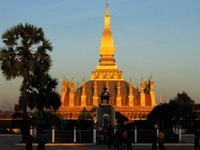
That Luang Stupa
That Luang Stupa is a symbol of Buddhism and Lao rule, and is the country's most important religious building. The golden temple and its spire are visible from afar, proving an unf…
That Luang Stupa
That Luang Stupa is a symbol of Buddhism and Lao rule, and is the country's most important religious building. The golden temple and its spire are visible from afar, proving an unforgettable welcoming sight for travellers. King Setthathirath built the shrine in 1566 and his statue stands in front of the temple, where the setting sun enhances the beauty of its already stunning golden surface. The central stupa is deeply symbolic: resembling a curved lotus bud, its three tiers represent different aspects of Buddhism. More specifically, the base deals with hell, the middle revolves around 30 Buddhist teachings and the top tier is about heaven. Visitors should explore the area with a local guide, who can explain the site's significance. They will also need to dress modestly, covering their knees and shoulders. Women can borrow traditional Lao skirts at the entrance.
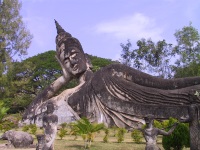
Xieng Khuan (Buddha Park)
The site known as Buddha Park is an otherworldly collection of Buddhist and Hindu statues scattered around a riverside meadow. Priest, myth-maker and sculptor, Luang Pu designed an…
Xieng Khuan (Buddha Park)
The site known as Buddha Park is an otherworldly collection of Buddhist and Hindu statues scattered around a riverside meadow. Priest, myth-maker and sculptor, Luang Pu designed and built the park in 1958, fusing philosophy with mythology and iconography. Visitors will discover that the detail on many of the statues is decidedly atypical of Laos. Indeed, much of it is quite unique. Visitors are sure to enjoy climbing and exploring the structures and should look out for tourist pleasers such as the beautiful Tree of Life sculpture and a pumpkin-like statue. The latter's steps lie inside its gaping mouth and lead to a viewing platform.
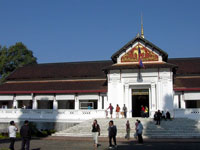
Royal Palace (Haw Kham)
The former Royal Palace is a mixture of French and Lao architecture. It preserves the monarchy's possessions and has an extremely opulent interior, with the Throne Room being the m…
Royal Palace (Haw Kham)
The former Royal Palace is a mixture of French and Lao architecture. It preserves the monarchy's possessions and has an extremely opulent interior, with the Throne Room being the most impressive. A three-headed elephant sheltered by the sacred white parasol sits above the entrance, and is the symbol of Laos' monarchy. The dazzling interior comprises mirrors, mosaics and displays of royal regalia that include glittering swords and the former King's elephant saddle. The Pha Bang (delicate Buddha) is the museum's most prized item, housed in a small, barred shrine that was the King's personal sanctum. Believed to have been crafted in the heavens, it's the country's most sacred image and spiritual protector.
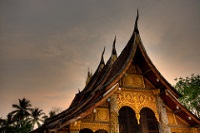
Wat Xieng Thong (Golden City Temple)
Situated at the tip of Luang Prabang's peninsula, the Golden City Temple (Wat Xieng Thong) is the country's most enchanting monastery and perhaps its most talked-about tourist attr…
Wat Xieng Thong (Golden City Temple)
Situated at the tip of Luang Prabang's peninsula, the Golden City Temple (Wat Xieng Thong) is the country's most enchanting monastery and perhaps its most talked-about tourist attraction. Its grandest feature may be the graceful, sweeping tiled roof of its main temple, though the stencilled gold designs on its walls are marvellous too. At the rear, visitors will find a splendid coloured-glass mosaic illustrating the 'tree of life'. The compound garden's peaceful atmosphere features several shelters, which house rare Buddha images and the gilded royal funerary carriage. If tourists can only explore one of the country's monasteries, it should be Wat Xieng Thong. Evenings see the light reflect beautifully off the glass and gold of the walls, while the monks are called into prayer by drums.
Plain of Jars (Phonsavan)
Located in the Xieng Khouang Plateau of Northern Laos, the mysterious Plain of Jars is an unusual sight and a must-see attraction. Visitors will find hundreds of huge stone jars sc…
Plain of Jars (Phonsavan)
Located in the Xieng Khouang Plateau of Northern Laos, the mysterious Plain of Jars is an unusual sight and a must-see attraction. Visitors will find hundreds of huge stone jars scattered about the landscape, some weighing as much as six tonnes and measuring around six feet in length. They're believed to be over 2,000 years old, though their origin and original function remain unknown. One story claims they were made to ferment rice wine to celebrate a victorious battle against a wicked chieftain in the 6th century. Others see them as sarcophagi or funerary urns. The jars are clustered into 90 groups, with Thong Hai Hin being the largest and most easily accessible site. Only Sites 1, 2 and 3 are open to visitors, as unexploded mines from the war lie around the other locations.
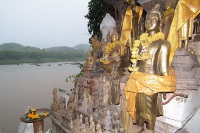
Pak Ou Caves
The Pak Ou Caves lie about two hours from Luang Prabang and are only accessible via a scenic boat trip. The lower and upper caves contain an impressive collection of mostly wooden …
Pak Ou Caves
The Pak Ou Caves lie about two hours from Luang Prabang and are only accessible via a scenic boat trip. The lower and upper caves contain an impressive collection of mostly wooden Buddha statues, which locals and pilgrims have assembled over the centuries. Hundreds of pilgrims journey to the caves every year, adding new statues to the gallery. The collection contains some unusual specimens, many of which are hard to reach. Visitors will need a flashlight to climb the stairs leading to the upper cave. The lower cave is visible from the river. Photos are permitted and visitors often light candles as tributes.
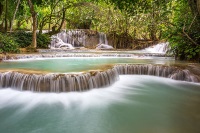
Kuang Si Falls
Tourists frequently rate the multi-tiered Kuang Si Falls as the top attraction in Luang Prabang. The serene location sees turquoise-green water tumble over a series of limestone te…
Kuang Si Falls
Tourists frequently rate the multi-tiered Kuang Si Falls as the top attraction in Luang Prabang. The serene location sees turquoise-green water tumble over a series of limestone terraces and collect in lovely pools, all of which are surrounded by lush greenery. Walkways lead around the base and to the summit, and visitors will find many places to picnic. The swimming is glorious, with rocks, branches and rope swings providing fun ways to enter the water. Given their natural splendour, it's no surprise that the falls get crowded. Travellers should visit as early as possible to fully appreciate the location and take good photographs. The falls are about 18 miles (29km) south of Luang Prabang.
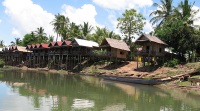
Si Phan Don
The famous 4,000 Islands region of Laos unfolds at the Mekong River's tail end. Situated in the far south and lapping over into Cambodia, the area is renowned for its tranquil vill…
Si Phan Don
The famous 4,000 Islands region of Laos unfolds at the Mekong River's tail end. Situated in the far south and lapping over into Cambodia, the area is renowned for its tranquil village life, spectacular waterfalls and unspoilt natural beauty. It's also home to the rare pink Irrawaddy Dolphin. The two most popular islands are Don Khong, which is the largest and most developed in the region, and backpacker magnet Don Det. Prices for food and accommodation are some of the cheapest in Asia. Many tourists use the area as an entry point into Cambodia, with buses frequently making the one-hour journey to the border. Action lovers can look forward to plenty of hiking, biking and swimming opportunities, while relaxation seekers can enjoy bungalows with waterside balconies. Water safaris are a great way to see the dolphins, though travellers should ask guides not to go too far. This way, they'll reduce the risks posed by strong currents, difficult navigation, limited rescue options, and the potential impact on wildlife.
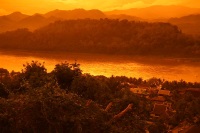
Phou Si
Phou Si is a hill lies near the confluence of the Khan and Mekong rivers, and is home to several caves, Buddha images and spectacular views of Luang Prabang. Visitors will find the…
Phou Si
Phou Si is a hill lies near the confluence of the Khan and Mekong rivers, and is home to several caves, Buddha images and spectacular views of Luang Prabang. Visitors will find the city's oldest temples on the lower slopes, but the area's most prized structure is the golden stupa of That Chomsi. It has become a symbol of Luang Prabang's spiritual significance to Laos. Travellers reach the stupa by climbing 300 steps and passing various temples and shady trees along the way. Some of the most interesting Buddha statues can be found via the back entrance. Climbing up one way and down the other would allow visitors to appreciate all the hill's sights and views, with some travellers visiting the night market, which they'll find in front of the Old Palace at the foot of Phou Si.


